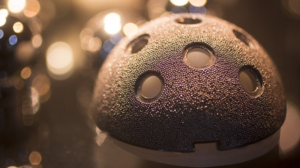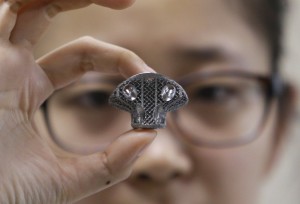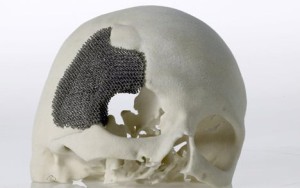The more Digital Healthcare makes breakthrough achievements and “3D scan-to-parts” becomes a routine the more medical applications of additive layer manufacturing (ALM) increase. Relying on medical scanning & imaging technologies (CT, MRI, and ultrasound), this new approach to healthcare offers more affordable and effective solutions, which are already on the way to alter existing supply chains. A noteworthy step on the path to “digital healthcare” is the American FDA’s clearance awarded to several printed medical devices.

Which medical “end-user” applications have already been additively manufactured?
– Generic items (hips, knees, shoulder implants, or plants accessories)e5
– Unique bespoke items (hearing aids, dental stones, shoe insoles, prosthetics ,and orthopedic implants)
– Patterns (used in downstream processes to fabricate dental crowns or dental aligners)
All medical sectors that have already adopted these 3D printed components benefit from a leaner supply chain. ALM doesn’t require multi-steps production operations or any additional tooling and minimizes the need for inventory. This leads to reduced costs and lead times, especially for small volumes and complex parts as in orthopedics.
Many surgeons are testing metal ALM processes for the fabrication of orthopedic implants and are about to successfully implement them because of the following advantages:
1) Biocompatible metal powders
Obtaining surfaces that generate expected responses from neighboring cells and tissues is of a major importance in the specification of surgical implants. Cell behavior (adhesion, functional alteration, morphological changes, and proliferation) is strongly affected by surface properties. Surface topography, surface chemistry, and surface energy govern the biological response to an implanted device.
 Preferred materials for the fabrication of implants are pure titanium and Ti6Al4V alloy. Pure titanium possesses a higher resistance to corrosion and is considered the most biocompatible metal. It spontaneously forms a stable and inert oxide layer as soon as its surface is exposed to an oxidizing media. If a higher strength is required in the biomedical implant, then a better choice is the Ti6Al4V alloy, which also exhibits good resistance to fatigue and corrosion with a low specific weight.
Preferred materials for the fabrication of implants are pure titanium and Ti6Al4V alloy. Pure titanium possesses a higher resistance to corrosion and is considered the most biocompatible metal. It spontaneously forms a stable and inert oxide layer as soon as its surface is exposed to an oxidizing media. If a higher strength is required in the biomedical implant, then a better choice is the Ti6Al4V alloy, which also exhibits good resistance to fatigue and corrosion with a low specific weight.
Other biocompatible materials available in powder form are stainless steel 316L and cobalt-chrome alloys. The highly controlled ALM atmosphere (neutral gases and restricted oxygen) ensures the high purity of the printed parts and preserves the expected material properties.
2) Cheaper “one-off” and bespoke metal implants
Compared to traditional manufacturing of customized implants, which is particularly time consuming and expensive, ALM is an intrinsically flexible process. The capital required to achieve a e3certain scope and design complexity is reduced, thus enabling individual customization.
Customized products provide superior comfort that leads to a faster recovery. Custom shapes optimize the distribution of stresses on bones and provide better adaptability which eliminates the need for manual handlings, performed by surgeons in the midst of a surgery. Failure risks are reduced, as are surgical time and overall costs.
3) Upgrade in mechanical properties
Better mechanical properties are reachable compared to traditional manufacturing techniques such as casting. The ALM process involves specific metallurgical aspects and gives birth to unique microstructures. Properly handled, refined grains are obtained due to the rapid heat extraction in the heat affected zone surrounding directly the laser-melt pool. As part of the ALM value chain, post-processing thermal treatments may also further improve pre-finished mechanical properties.
As a consequence, the parts are lighter with a slightly reduced section thickness. This decreases the patient’s  discomfort without sacrificing the possibility for freeform and complex near-net shapes.
discomfort without sacrificing the possibility for freeform and complex near-net shapes.
4) Synergies between ALM and orthopedic metal implants
Titanium has a high elastic modulus which causes elasticity mismatch between the implant and the bones and limits the adoption of the material. A low elastic Young’s modulus helps to avoid “stress shielding” (removal of normal stress from the bone by an implant) which causes a reduction in bone density. As it is a unique process able to build objects with a controlled degree of e2porosity, metal ALM can solve this issue by varying the volume fraction and size distribution of the porous structures. Indeed, the elastic modulus of porous titanium decreases with an increasing pore size and implants can be tailored to have similar mechanical properties to those of human bone.
Furthermore, metal implants traditionally shaped by subtractive manufacturing usually undergo a porous surface coating to facilitate bone ingrowth and overall implant cohesion. Metal ALM enables the combination of a dense load-bearing structure providing strength with a precise and interconnected open porosity inducing bone ingrowth. Last but not least, when bone-implant fixing is required, the rough surface of ALM pre-finished parts allows eliminating downstream coating operation and saves time and money.
To conclude:
As tailored medical devices lead to fewer downside effects and faster patient recovery, they are undoubtedly relevant in the field of surgical bio-implants.
While new applications and quality improvements are yet to come, metal additive manufacturing is already successfully reshaping current supply chains for numerous orthopedic implants, minimizing high-costs and long lead-times.



